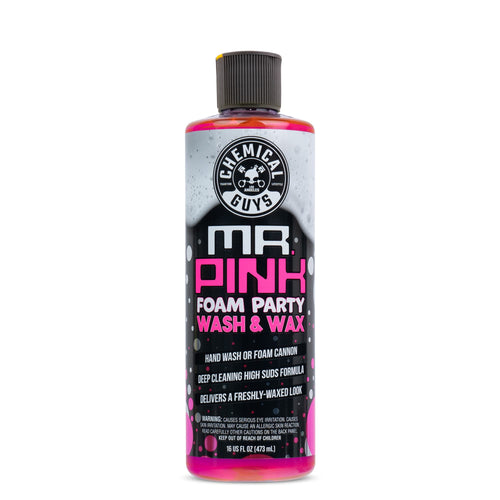Foam cleaners aren't just for show – they're a trusted favorite in garages for a reason. This is the detailer's secret weapon, from thick suds that cling like a magnet to road grime to an easy rinse that feels downright satisfying. Below, we’ll break down what foam cleaner is, what gear you need, and why it’s earned a permanent place in every serious wash routine.
What Is Foam Cleaner, and What Equipment Is Required?
Foam cleaners are high-lubrication soaps designed to loosen and lift grime before your mitt touches the surface. The dense foam clings to every curve of your car by pulling contaminants away from the paint so you’re not grinding dirt into the finish. It’s the prep stage your car deserves – and the results speak for themselves.
You’ll want a foam cannon or gun to get that rich foam effect. Foam cannons hook up to a pressure washer and produce thick, snow-like suds. Foam guns connect to a standard hose and still deliver great coverage. Both tools enhance your wash routine and make the process more enjoyable.
How Foam Cleaners Power Through Grime
Foam cleaners use surfactants to break the bond between dirt and your paint. Once sprayed on, the foam grabs hold of grime, road salt, and other stubborn messes, allowing them to be rinsed away clean. That cling time gives the formula space to do its thing, softening buildup so you don’t have to scrub as hard.
The thick foam also provides a visual indicator of coverage, ensuring no spot is left behind. Loosening contaminants before you touch the surface, foam creates a cleaner starting point, leading to better results with less effort. It’s a simple upgrade that protects your car’s finish and boosts shine every time you wash.
Benefits of Using Foam Cleaners on Your Vehicle
Foam cleaners offer way more than good looks. From serious cleaning power to that satisfying swirl of thick suds, they make the entire wash process smoother, safer, and more enjoyable.
- Lifts Dirt Fast: High-lubrication foam grabs onto grime and lifts it from the surface before you reach for your mitt. That layer of cushioning keeps your paint safer with every wash.
- Covers Every Inch: Foam cannons and guns deliver full-body coverage across panels, trim, and tight spots. There is no need to chase missed areas – just spray, soak, and rinse.
- Protects Your Finish: The foam acts as a barrier, helping reduce friction during contact wash. This results in fewer swirls, fewer scratches, and a cleaner finish every time.
- Works for Everyone: Whether washing a daily driver or a garage-kept classic, foam cleaners keep things simple. The process is approachable, and the results are professional.
- Satisfies the Detailer in You: Watching those suds roll down the paint hits the sweet spot between function and fun. It’s an upgrade that feels good every time you spray.
Foam Cleaning vs. Traditional Washing Methods
Every detailer has a preferred approach to wash routines. Some enjoy the hands-on process of a traditional bucket wash, while others opt for foam cannons to speed up the process. Both styles achieve the desired outcome, but the experience and workflow can vary. Below, we’ll break down what each method offers and how they compare in terms of time, coverage, and ease.
Foam Cleaning
Foam cleaning covers your ride in a rich layer of suds that sticks to the surface and lifts dirt before your mitt comes close. The foaming action helps loosen grime and lift debris from the surface, making the wash process smoother and safer. Foam cannons and foam guns coat the vehicle quickly and consistently, saving time and improving overall coverage. The reduced contact needed during washing helps minimize the risk of swirl marks. Many detailers prefer foam for its efficiency and consistent results, especially when working with large vehicles or intricate trim.
Traditional Washing Methods
Traditional washes rely on soap, water, and a steady hand. This approach offers complete control over every panel and works well for spot cleaning or working in tight areas. A proper two-bucket method and quality mitt still provide excellent results. This method may take longer, but many detailers enjoy the process and the closer connection to their vehicle. From classics in the garage to daily drivers in the driveway, traditional washing remains a tried-and-true routine with a loyal following.


